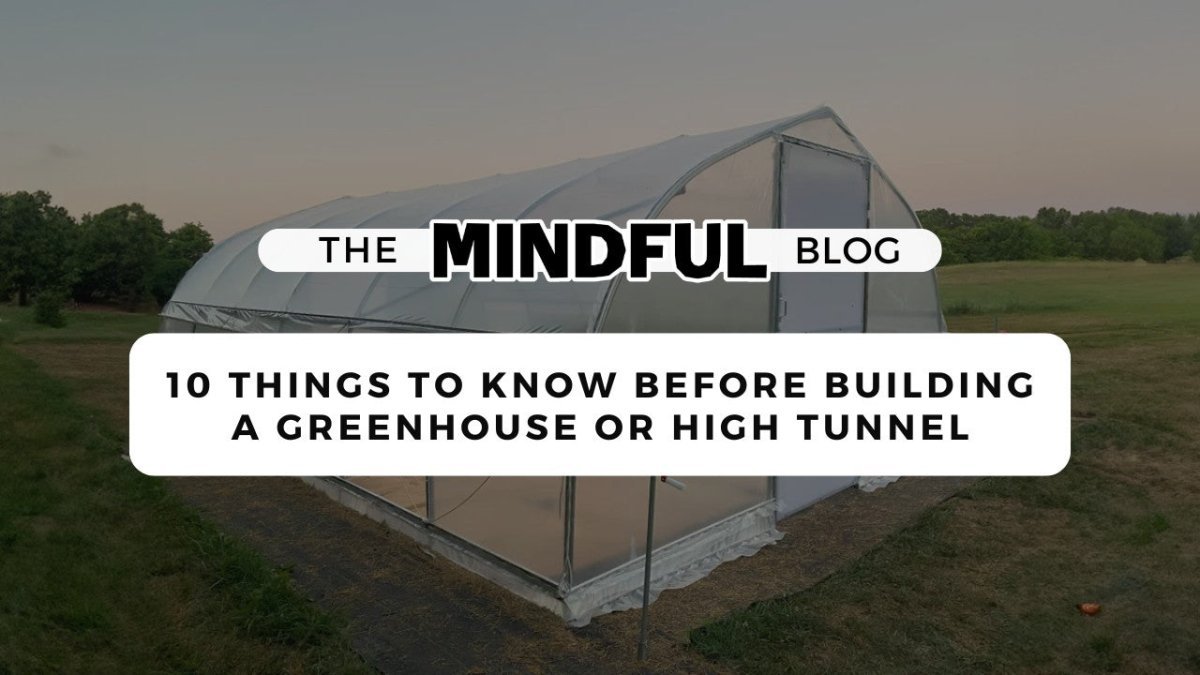
Greenhouses and high tunnels are powerful tools for extending your growing season, improving crop quality, and protecting your plants from unpredictable weather. Whether you're farming for market production or managing a productive backyard garden, these structures offer endless possibilities—but getting started requires careful planning. Here’s what I’ve learned over the years to help you make the most of your investment.
1. Evaluate Your Goals and Growing Needs
Before you start building, get clear on why you want a greenhouse or high tunnel. Are you aiming to extend your growing season for cool-weather crops? Start transplants earlier? Protect delicate plants from frost? Your goals will influence everything from the size and structure to the features you need.
For growers aiming to boost production, high tunnels are a fantastic choice for passive season extension. On the other hand, if you're focused on tropical plants, year-round production, or tight climate control, a greenhouse might be the better option.
Think long-term: Will your current space and setup allow for expansion as your operation grows? A little extra planning now can save you from outgrowing your structure later.
2. Understand the Differences Between High Tunnels and Greenhouses
While both structures protect your crops, their functionality differs:
- High Tunnels: Unheated, passive structures that rely on sunlight for warmth. Ideal for extending seasons and protecting crops without the cost of climate control.
- Greenhouses: Fully enclosed with heating and cooling systems to maintain stable growing conditions year-round. Best for more sensitive crops or intensive production.
For example, I rely on high tunnels for most of my field crops, adding a second layer of plastic when winter approaches to push my growing zone south. For more temperature-sensitive starts or specific plants, a greenhouse with supplemental heat offers greater precision.
3. Choose a Location That Works for Your Garden
Your structure’s location can make or break its effectiveness. Prioritize areas with maximum sunlight—ideally 6–8 hours of direct light daily. Avoid spots with heavy shade or where strong winds could strain the structure.
Proximity to water and electricity can also simplify day-to-day operations. I’ve found that easy access to a water source saves time during peak planting or harvest periods, especially when irrigation systems are involved.
4. Think About Airflow and Ventilation Early
Ventilation is critical for healthy plants. For high tunnels, roll-up sides or drop-down curtains are key for managing airflow. In greenhouses, a combination of fans, vents, and automated controls prevents overheating and ensures even humidity.
Poor ventilation can lead to fungal diseases, so investing in a solid airflow system pays off in the long run.
5. Plan Your Soil and Watering Systems
The soil inside your structure needs regular attention. Amending it with compost or organic matter keeps it rich and ready for productive growth. For watering, drip irrigation is my go-to—it delivers moisture directly to the roots, conserving water and reducing disease risks.
Whether you’re working with grow bags, in-ground rows, or raised beds, pairing good soil with consistent watering will give you healthier, more productive plants.
6. Prepare for Pests Proactively
A greenhouse or high tunnel won’t eliminate pests, but it can reduce them—if you manage it properly. Start with clean soil, regularly monitor for pests, and use preventative measures like row covers or companion planting.
I also recommend having natural pest controls like neem oil, insecticidal soaps, or beneficial insects (ladybugs and lacewings are personal favorites) on hand.
7. Weigh DIY vs. Prefabricated Options
There’s no right answer when it comes to DIY vs. prefabricated kits—it depends on your budget, experience, and goals. Prefabricated options like Mindful Farmer’s NRCS-certified high tunnel kits are designed for quick assembly and long-term durability. For those who enjoy a hands-on project, building a structure from scratch can save costs but requires more time and planning.
Either way, focus on choosing materials that can handle your region’s weather conditions.
8. Budget for Heating and Cooling
In high tunnels, passive heat from sunlight is often sufficient. Double layers of plastic can help retain heat during colder months. For greenhouses, electric or propane heaters and circulation fans ensure a stable climate.
For my setups, shade cloths are a simple but effective solution for reducing heat during summer, while supplemental heat keeps tender crops alive during unexpected freezes.
9. Get Familiar with NRCS EQIP Support
If you’re planning to invest in a high tunnel, look into the NRCS Environmental Quality Incentives Program (EQIP). Many of our customers have secured cost-sharing grants that cover 90–100% of the cost of a high tunnel.
At Mindful Farmer, we’ve designed our kits to meet NRCS specifications, so you can take full advantage of these opportunities while building a structure that fits your goals.
10. Prioritize Long-Term Durability
Your structure is an investment, so it’s worth choosing materials that will last. High-quality frames, UV-resistant plastics, and reliable hardware minimize maintenance headaches and maximize the life of your greenhouse or high tunnel.
I’ve seen many growers regret cutting corners on materials—it’s far better to invest upfront than to replace a failing structure a year or two later.
Build Smarter, Grow Better
Adding a greenhouse or high tunnel to your setup is a big step, but with proper planning, it can transform your gardening or farming operation. Whether you’re extending your season, protecting plants, or growing year-round, these structures make it possible to work smarter, not harder.
At Mindful Farmer, we’re here to help you every step of the way. From NRCS-approved high tunnels to expert advice, we’ve got the tools you need to grow sustainably and effectively. Have questions or ready to get started? Reach out to us—we’d love to hear from you!
